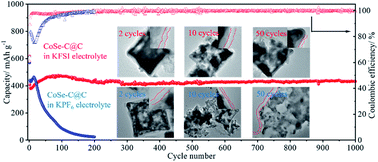A CoSe–C@C core–shell structure with stable potassium storage performance realized by an effective solid electrolyte interphase layer†
Abstract
Conversion/alloying materials with high theoretical capacity are promising for potassium-ion batteries, although their development is seriously blocked owing to their volume expansion and ineffective solid-electrolyte interphase (SEI) protection. Herein, it is discovered that the performance of the CoSe anode material could be enhanced through a flexibly designed core–shell structure (denoted as CoSe–C@C) and an inorganic compound-rich SEI. The CoSe–C@C electrode exhibits stable cycling performance (432 mA h g−1 at 200 mA g−1) over 1000 cycles and outstanding rate capability (233 mA h g−1 at 10 A g−1). A reversible conversion mechanism for the potassiation/depotassiation in CoSe is revealed by ex situ X-ray diffraction patterns and high-resolution transmission electron microscope images, while the SEI on the CoSe–C@C surface is found to be inorganic-rich (KF-), which is favourable for K ion diffusion and charge transfer dynamics. These findings would shed light on nanostructure design strategies and our fundamental understanding of the SEI formation in electrolyte engineering for potassium-ion batteries.



 Please wait while we load your content...
Please wait while we load your content...